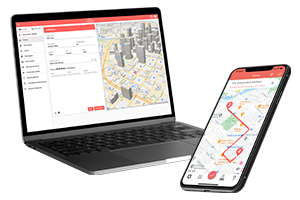Last updated: September 15, 2023
Driving is an essential part of everyday work for millions of Americans. If you’re one of them, you might be eligible for a cost deduction on your federal income tax return.
Gig workers, real estate agents, self-employed people, and small business owners are all able to deduct the miles they accrue while traveling for work. Members of the military and people who work for a charitable organization can also deduct a fixed amount for every mile they drive.
There are 2 ways to calculate the mileage deduction amount and I’m going to show you both, along with other details you need to know to keep a mileage log that is 100% sufficient for any IRS audits.
“How do I know if I qualify for mileage tax deduction?”
There are 4 kinds of mileage rates:
- Business
- Medical
- Moving
- Charity
If you conduct business-related errands with your vehicle, you’re eligible for a business mileage tax deduction.
For instance, if you’re the owner of a construction working company, the miles you drive from the office to a worksite are considered business miles and, therefore deductible as a business expense.
How much is the standard mileage rate?
The IRS sets the standard mileage rate for businesses at the end of every year, adjusting it for inflation- in fact, the IRS increased the standard mileage rate from 62.5 cents to 65.5 cents per mile for 2023.
If you visit medical appointments, you’re able to deduct a certain amount of money per mile as a medical mileage tax deduction.
If you’re an active member of the military, moving between posts is deductible (the rate for moving is usually the same as the medical rate, in 2023 this number remains 22 cents per mile).
If you work for a charity organization, you’re also able to deduct some money after every mile you drive. The charity mileage rate has been 14 cents per mile since 2011.
Standard Mileage Rate vs. Actual Expense Method
These are the 2 types of methods you can choose from when you start using a car for business purposes – these are the standard mileage rate and the actual expense method.
Most important notes about these 2 methods:
- If you choose the actual method for the first year of using a car for business, you must stick to using that method as long as you use that car for business
- If you choose the actual expense method, you don’t have to keep a mileage log, however, you must keep all the receipts from everywhere you go to purchase something related to that vehicle
- If you choose the standard mileage rate, you don’t have to keep your receipts, however, you must keep a mileage log of your business trips
- It’s recommended to go with the standard mileage rate for the first year and calculate your financials as you’ll be able to switch back and forth between the 2 methods for any year in that case
- The actual expense method is usually more profitable if you have a really expensive car that you spend lots of money on

Record Your Odometer at the Start & End of Each Year
As I mentioned above, if you go with the standard mileage rate, you’ll need to keep a mileage log. The very first step for that is to record your odometer at the beginning and the end of each year as you’ll need to put that number in your Form 2106.
If you purchased a used vehicle, record the odometer reading on the first day you start using it.
It’s also imperative that you record the odometer reading at the end of each year as that number will be used to calculate your business miles for which you’ll get a business mileage tax deduction.
Note: Using MileageWise, you’ll be asked to record your mileage at the start & the end of each month to make this process easier. Recording your mileage once a year usually makes the calculation harder and can cause chaos if there’s any miscalculation.
For Actual Expense Method: Keep Your Receipts
For drivers who chose AEM (Actual Expense Method), the single most important thing for their business mileage tax deduction is to maintain their records of relevant receipts, invoices, and all other documentation. Each of these must contain the date, the price of the purchase, and the description of the service or the product purchased.
If you qualify for the AEM, you can deduct expenses from gas, oil, repairs, tires, lease payments, depreciation, registration expenses, tolls, parking, insurance, and any other vehicle-related expense.

For Standard Mileage Rate: Keep an IRS-approved mileage log
If you decide to go with the standard mileage rate as most Americans do, you’ll need to keep a mileage log.
There are 3 major methods to do that:
- Pen-and-paper
- Excel mileage log template or Google Sheets mileage log template
- Automatic mileage tracker app on your phone
The first and the second option take a massive amount of time to create and you can never be sure that the data you put there is valid and lacks any mistakes that would make the IRS decline your mileage tax claim.
This is why nowadays the most popular, efficient, quick, and profitable option is having a mileage tracker application like MileageWise on your phone.
The even better news is that MileageWise is not only a mileage tracker app on your phone: Every single trip you create automatically or manually will be stored in MileageWise’s web dashboard platform, where you can check, edit your monthly trips anytime and you can finalize your IRS-approved mileage log in 7 minutes a month.
It doesn’t sound like too much time, does it? 🙂
Before printing your mileage log, MileageWise’s built-in IRS auditor function checks and corrects 70 logical contradictions in your mileage log, making sure that the outcome is 100% IRS-compliant.
Did you forget to track your business miles?
No worries, MileageWise’s AI Wizard feature gives you recommendations for your lost miles, based on the locations of your clients.
The more clients you have added to the software, the more precise recommendation you can get for your forgotten past miles… if you’re not satisfied with the trip recommendation, you can restart AI Wizard and you get a new trip recommendation in a couple of minutes.
Google Maps Mileage Log
If you have GPS tracking turned on in your Google account, Google tracks you everywhere you go. If you need your past trips and you forgot to keep a mileage log, MileageWise helps you create an IRS-approved mileage log from those trips.
MileageWise is here to the rescue if you need a truly IRS-approved mileage log. 🙂
See Why The Wise Choose MileageWise
| MileageWise | TripLog | MileIQ | Everlance | Driversnote | SherpaShare | Hurdlr | Excel | |
User Ratings (Trustpilot) | N/A | N/A | N/A | N/A | N/A | |||
iOS App User Ratings | ||||||||
Android App User Ratings |
| |||||||
Average Possible Business Mileage Deduction | $12,000 | $6,300 | $6,500 | $6,500 | $6,000 | $5,600 | $5,600 | $200-$2,000 |
Imports Trips and locations from Google Timeline | ||||||||
Produces IRS-Proof Mileage Logs | ||||||||
Creates Retrospective Mileage Logs | ||||||||
AI Wizard Technology for Mileage Recovery | ||||||||
| Sampling / Recurring Daily Trips | ||||||||
| Mass Distance Calculation | ||||||||
| Built-In IRS Auditor for 70 Logical Conflicts Correction | ||||||||
| Web Dashboard | ||||||||
| Mileage Tracker App | ||||||||
| Vehicle Expense Tracker | ||||||||
| Manual Trip Recording | ||||||||
| Bluetooth Auto Tracking - with no hardware needed | ||||||||
| Plug'N'Go Auto Tracking | ||||||||
| Vehicle Movement Monitoring | ||||||||
| Battery and Data Friendly | ||||||||
| Other Software Integrations | ||||||||
| Trip List Import from other Mileage Trackers | ||||||||
| Trip List Import from GPS | ||||||||
| Shared Dashboard for Teams | ||||||||
Features are all related to mileage tracking | ||||||||
Pricing | Price list | Price list | Price list | Price list | Price list | Price list | Price list | Price list |
Similar blog posts
- IRS Increases Business Mileage Rate - June 10, 2022
- Can I Switch From Actual Expenses to Standard Mileage? - June 13, 2022
- Mileage Software Reinvented: The Magic of MileageWise - June 24, 2023
- Free MileageWise Live Demo for $1,000s of annual tax savings - September 2, 2022
- Leveraging the Standard Mileage Deduction for Your Business - May 22, 2023



